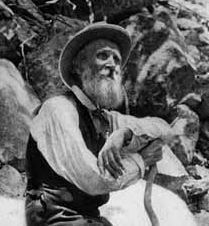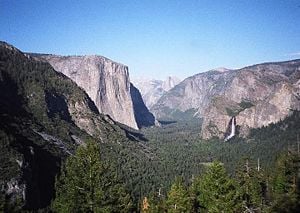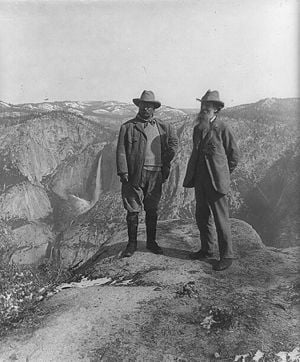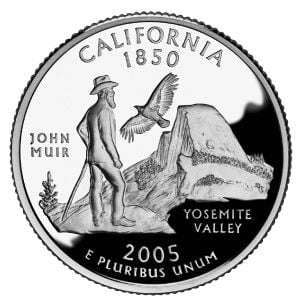Difference between revisions of "John Muir" - New World Encyclopedia
| Line 5: | Line 5: | ||
==Biography== | ==Biography== | ||
| − | Muir was born in | + | John Muir was born in Dunbar, East Lothian, Scotland to Daniel Muir and Ann Gilrye. He was the third of eight children being preceded by Margaret and Sarah and followed by David, Daniel, Ann and Mary (twins) and the American born Joanna. Daniel Muir was a grain merchant and a preacher with the Disciples of Christ. |
| − | Muir emigrated to the [[United States]] in | + | The Muir family emigrated to the [[United States]] in 1849 and started a farm in Marquette County, Wisconsin; which was then wilderness. The children had to work very hard to help clear the land and run the farm. A lot of the responsibility fell to John as the oldest son, and also his father was often away doing church work. He had a great interest in and love of nature and all living things. He later wrote of a horse that had died from overwork: |
| + | |||
| + | :She was the most faithful, intelligent, playful, affectionate, human-like horse I ever knew, and she won all our hearts. Of the many advantages of farm life for boys one of the greatest is the gaining a real knowledge of animals as fellow-mortals, leaving to respect them and love them, and even to win some of their love. Thus godlike sympathy grows and thrives and spreads far beyond the teachings of churches and schools, where too often the mean, blinding, loveless doctrine is taught that animals have neither mind nor soul, have no rights that we are bound to respect, and were made only for man, to be petted, spoiled, slaughtered, or enslaved. [[*|http://www.yosemite.ca.us/john_muir_writings/the_story_of_my_boyhood_and_youth/chapter_3.html]] | ||
| + | |||
| + | |||
| + | |||
| + | He attended the [[University of Wisconsin]] for several years, but instead of graduating from a school built by the hand of man, Muir opted to enroll in the "university of the wilderness" and thus walked a thousand miles from [[Indiana]] to [[Florida]] after spending most of the years [[1866]] and [[1867]] working as an industrial [[engineer]] in [[Indianapolis, Indiana|Indianapolis]], where a factory accident almost cost him his eyesight. He had planned to continue on to [[South America]], but was stricken by [[malaria]] and went to [[California]] instead. | ||
[[image:Yosemite Valley from Inspiration Point in Yosemite NP.JPG|thumb|left|300px|Yosemite Valley from Inspiration Point]] | [[image:Yosemite Valley from Inspiration Point in Yosemite NP.JPG|thumb|left|300px|Yosemite Valley from Inspiration Point]] | ||
Revision as of 16:48, 25 May 2006
John Muir (April 21, 1838 – December 24, 1914) was one of the earliest, and perhaps the most important of, modern conservationists.
Biography
John Muir was born in Dunbar, East Lothian, Scotland to Daniel Muir and Ann Gilrye. He was the third of eight children being preceded by Margaret and Sarah and followed by David, Daniel, Ann and Mary (twins) and the American born Joanna. Daniel Muir was a grain merchant and a preacher with the Disciples of Christ.
The Muir family emigrated to the United States in 1849 and started a farm in Marquette County, Wisconsin; which was then wilderness. The children had to work very hard to help clear the land and run the farm. A lot of the responsibility fell to John as the oldest son, and also his father was often away doing church work. He had a great interest in and love of nature and all living things. He later wrote of a horse that had died from overwork:
- She was the most faithful, intelligent, playful, affectionate, human-like horse I ever knew, and she won all our hearts. Of the many advantages of farm life for boys one of the greatest is the gaining a real knowledge of animals as fellow-mortals, leaving to respect them and love them, and even to win some of their love. Thus godlike sympathy grows and thrives and spreads far beyond the teachings of churches and schools, where too often the mean, blinding, loveless doctrine is taught that animals have neither mind nor soul, have no rights that we are bound to respect, and were made only for man, to be petted, spoiled, slaughtered, or enslaved. http://www.yosemite.ca.us/john_muir_writings/the_story_of_my_boyhood_and_youth/chapter_3.html
He attended the University of Wisconsin for several years, but instead of graduating from a school built by the hand of man, Muir opted to enroll in the "university of the wilderness" and thus walked a thousand miles from Indiana to Florida after spending most of the years 1866 and 1867 working as an industrial engineer in Indianapolis, where a factory accident almost cost him his eyesight. He had planned to continue on to South America, but was stricken by malaria and went to California instead.
Arriving in San Francisco in March 1868, Muir immediately left for a place he had only read about called Yosemite. After seeing Yosemite Valley for the first time he was captivated, and wrote, "No temple made with hands can compare with Yosemite," and "[Yosemite is] the grandest of all special temples of Nature."
After his initial eight-day visit, he returned to the Sierra foothills and became a ferry operator, sheepherder and bronco buster. In May 1869 a rancher named Pat Delaney offered Muir a summer job in the mountains to accompany and watch over Delaney's sheep and sheepherder. Muir enthusiastically accepted the offer and spent that summer with the sheep in the Yosemite area. That summer Muir climbed Cathedral Peak, Mount Dana and hiked the old Indian trail down Bloody Canyon to Mono Lake. During this time he started to develop his theories about how the area developed and how its ecosystem functioned.
Now more enthusiastic about the area than before, Muir secured a job operating a sawmill in the Yosemite Valley under the supervision of innkeeper James Hutchings. A natural born inventor, Muir designed a water-powered mill to cut wind-felled trees and he built a small cabin for himself along Yosemite Creek.
Pursuit of his love of science, especially geology, often occupied his free time and he soon became convinced that glaciers had sculpted many of the features of the valley and surrounding area. This notion was in stark contradiction to the accepted theory of the day, promulgated by Josiah Whitney (head of the California Geological Survey), which attributed the formation of the valley to a catastrophic earthquake. As Muir's ideas spread, Whitney would try to discredit Muir by branding him as an amateur and even an ignoramus. The premier geologist of the day, Louis Agassiz, however, saw merit in Muir's ideas, and lauded him as "the first man who has any adequate conception of glacial action."
In 1871 Muir discovered an active alpine glacier below Merced Peak, which further helped his theories to gain acceptance. He was also a highly productive writer and had many of his accounts and papers published as far away as New York. Also that year, one of Muir's heroes, Ralph Waldo Emerson, arrived in Yosemite and sought Muir out. Muir's former professor at the University of Wisconsin, Ezra Carr, and Carr's wife Jeanne encouraged Muir to publish his ideas. They also introduced Muir to notables such as Emerson, as well as many leading scientists such as Louis Agassiz, John Tyndall, John Torrey, Clinton Hart Merriam, and Joseph LeConte.
A large earthquake centered near Lone Pine, California in Owens Valley (see 1872 Lone Pine earthquake) was felt very strongly in Yosemite Valley in March 1872. The quake woke Muir in the early morning and he ran out of his cabin without fear exclaiming, "A noble earthquake!" Other valley settlers, who still adhered to Whitney's ideas, feared that the quake was a prelude to a cataclysmic deepening of the valley. Muir had no such fear and promptly made a moonlit survey of new talus piles created by earthquake-triggered rockslides. This event led more people to believe in Muir's ideas about the formation of the valley.
In addition to his geologic studies, Muir also investigated the living Yosemite area. He made two field studies along the western flank of the Sierra of the distribution and ecology of isolated groves of Giant Sequoia in 1873 and 1874. In fact, in 1876 the American Association for the Advancement of Science published a paper Muir wrote about the trees' ecology and distribution.
In 1880 Muir married Louisa Wanda Strentzel, the only child of a wealthy landowners and from 1882 spent 8 years managing the ranch and fruit farm given to him by his father-in-law. During this time two daughters were born to him, Wanda and Helen.
From studying to protecting
Muir's attention soon started to switch from studying the Yosemite area and Sierra to protecting it. A precipitating event for him was the discovery of a sign illegally claiming private ownership in Kings Canyon, and loggers cutting down ancient Giant Sequoia groves south of present day Sequoia National Park.
Muir threw himself into his new role with great vigor. He saw the greatest threat to the Yosemite area and the Sierras to be livestock, especially domestic sheep (calling them "hooved locusts"). In June 1889, the influential associate editor of Century magazine, Robert Underwood Johnson, camped with Muir in Tuolumne Meadows and saw firsthand the damage a large flock of sheep had done to the grassland. Johnson agreed to publish any article Muir wrote on the subject of excluding livestock from the Sierra high country. He also agreed to use his influence to introduce a bill to Congress that would make the Yosemite area into a national park, modeled after Yellowstone National Park.
A bill essentially following recommendations that Muir put forward in two Century articles ("The Treasure of the Yosemite" and "Features of the Proposed National Park", both published in 1890), was passed by Congress on September 30, 1890. To the dismay of Muir, however, the bill left Yosemite Valley in state control. Also in 1890, Muir settled in Martinez, California. His home is now the John Muir National Historic Site.
With this partial victory under his belt, Muir helped form an environmental organization called the Sierra Club on May 28, 1892 and was elected as its first president (a position he held until his death 22 years later).
In July of 1896 Muir became good friends with another leader in the conservation movement, Gifford Pinchot. That friendship was ended late in the summer of 1897 when Pinchot released a statement to a Seattle newspaper supporting sheep grazing in forest reserves. Muir confronted Pinchot and demanded an explanation. When Pinchot reinerated his position Muir told him "I don't want any thing more to do with you" This philosophical divide soon expanded and split the conservationist movement into two camps: the preservationists, led by Muir, and Pinchot's camp, who co-opted the term "conservationist." Muir was deeply opposed to commercializing nature. The two men debated their positions in popular magazines as Outlook, Harper's Weekly, Atlantic Monthly, World's Work, and Century. Muir argued for the preservation of resources for their spiritual and uplifting values; Pinchot saw conservation as a means of intelligently managing the nation's resources. Both men opposed reckless exploitation of natural resources, including clear-cutting of forests.
In 1899, Muir accompanied railroad executive E. H. Harriman on his famous exploratory voyage along the Alaska coast aboard the luxuriously refitted 250-foot steamer called the "George W. Elder. He would later rely on his friendship with Harriman to apply political pressure on Congress to pass conservation legislation.
In 1903 President Theodore Roosevelt accompanied Muir on a visit to the park. Muir joined Roosevelt in Oakland, California for the train trip to Raymond. The presidential entourage then traveled by stagecoach into the park. While traveling to the park, Muir told the president about state mismanagement of the valley and rampant exploitation of the valley's resources. Even before they entered the park, he was able to convince Roosevelt that the best way to protect the valley was through federal control and management.
After entering the park and seeing the magnificent splendor of the valley, the president asked Muir to show him the real Yosemite. Muir and Roosevelt set off largely by themselves and camped a few ranges into the backcountry. While circling around a fire, the duo talked late into the night, slept in the brisk open air and were dusted by a fresh snowfall in the morning - a night Roosevelt never would forget.
Muir then increased efforts by the Sierra Club to consolidate park management and was rewarded in 1905 when Congress transferred the Mariposa Grove and Yosemite Valley into the park.
Pressure then started to mount to dam the Tuolumne River for use as a water reservoir for San Francisco. The damming of Hetch Hetchy Valley was passionately opposed by Muir who called Hetch Hetchy a "second Yosemite." Muir, the Sierra Club and Robert Underwood Johnson fought against inundating the valley and Muir even wrote Roosevelt pleading for him to scuttle the project. After years of national debate that polarized the nation, Roosevelt's successor, Woodrow Wilson signed the dam bill into law on December 19, 1913. Muir felt a great loss from the destruction of the valley, his last major battle.
John Muir died in Los Angeles on December 24, 1914 after a brief visit to his daughter Wanda. Some, such as Steve Roper, a California climber, say he died of a "broken heart" [1]
Muir's estate was worth $250, 000 when he died, equivalent to about $4 million today.
The John Muir Trail, the John Muir Wilderness, the Muir Woods National Monument, John Muir College (a residential college of the University of California, San Diego), and John Muir Country Park in Dunbar are named in his honour. An image of John Muir, with the California Condor and Half Dome, appears on the California state quarter which was released in 2005.
Quote
- "Most people are on the world, not in it; have no conscious sympathy or relationship to anything about them, undiffused, separate, and rigidly alone like marbles of polished stone, touching but separate." John Muir Information Guide - On People and the Wilderness
Reference
Primary sources
- Muir, John. John Muir: Nature Writings: The Story of My Boyhood and Youth; My First Summer in the Sierra; The Mountains of California; Stickeen; Essays (Library of America edition ed, by William Cronon (1997)
Secondary sources
- Gretel Ehrlich. John Muir: Nature's Visionary (2000)
- Meyer, John M. "Gifford Pinchot, John Muir, and the Boundaries of Politics in American Thought" Polity 1997 30(2): 267-284. Issn: 0032-3497
- Miller, Char . Gifford Pinchot and the Making of Modern Environmentalism (2001)
- Smith, Michael B. "The Value of a Tree: Public Debates of John Muir and Gifford Pinchot" Historian 1998 60(4): 757-778. Issn: 0018-2370
- Linnie Marsh Wolfe. Son of the Wilderness: The Life of John Muir (1945; 2nd ed 2003)
- Yosemite: A Visitor's Companion, George Wuerthner, (Stackpole Books; 1994; pages 25-37) ISBN 0-8117-2598-7
- Turner, Fredrick. (1985) Rediscovering America, John Muir in His Time and Ours ISBN 0871567040
See also
- John Muir Trust, Scottish charity
- John Muir High School (Pasadena, California), high school
- Muir Woods, in Northern California
- Timeline of environmental events
External links
- Works by John Muir. Project Gutenberg
- John Muir Writings. Complete text online of Muir's books
- Manuscript letters, 1861-1914 put online by the Wisconsin Historical Society
- John Muir Exhibit by the Sierra Club
- John Muir Global Network
- John Muir Memorial Association California
- John Muir Middle School Wausau, Wisconsin
- John Muir National Historic Site from National Park Service
- Dunbar's John Muir Association Scotland
- John Muir Birthplace Trust Scotland
- John Muir Trust Scotland
- John Muir In Indianapolis Historical Marker
- John Muir Project Protecting Federal Public Forest Lands
Credits
New World Encyclopedia writers and editors rewrote and completed the Wikipedia article in accordance with New World Encyclopedia standards. This article abides by terms of the Creative Commons CC-by-sa 3.0 License (CC-by-sa), which may be used and disseminated with proper attribution. Credit is due under the terms of this license that can reference both the New World Encyclopedia contributors and the selfless volunteer contributors of the Wikimedia Foundation. To cite this article click here for a list of acceptable citing formats.The history of earlier contributions by wikipedians is accessible to researchers here:
The history of this article since it was imported to New World Encyclopedia:
Note: Some restrictions may apply to use of individual images which are separately licensed.





